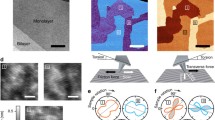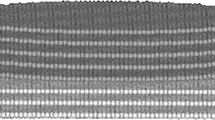Abstract
To identify the relation between torque and superlubric motion, we investigate the interlayer sliding behavior of two graphene disks with numerical computation methods. The potential energy, lateral force and torque between the top and bottom graphene disks, which are associated with misfit angle, translational displacement and interlayer distance, are analyzed. The results show that the rotation of the top disk is feeble for commensurate state, but it is difficult to realize superlubricity due to the lateral force fluctuating remarkably. For incommensurate state, the flake exhibits vanishing torque approaching to zero only for partial sliding directions. The superlubricity between the top and bottom disks will be eliminated due to torque-induced reorientation along other sliding directions. Whether for commensurate or incommensurate contact, the amplitudes of the lateral force (516 pN and 13 pN, respectively) are in qualitative agreement with experimental observation (typically 250 pN and 50 pN, respectively). It shows that the interlayer torque is insensitive to the top disk size with incommensurate contact. The results suggest that the superlubric motion of graphene disk can be controlled by adjusting the torque.
Similar content being viewed by others
References
Guo Y F, Guo W L, Chen C F. Modifying atomic-scale friction between two graphene sheets: A molecular-force-field study [J]. Physical Review B, 2007, 76: 155429–155433.
Kim S Y, Park H S. Multilayer friction and attachment effects on energy dissipation in graphene nanoresonators [J]. Applied Physics Letters, 2009, 94: 101918–101920.
Filleter T, McChesney J L, Bostwick A, et al. Friction and dissipation in epitaxial graphene films [EB/OL]. [2014-05-16]. http://journals.aps.org/prl/abstract/10.1103/PhysRevLett.102.086102.
Hirano M, Shinjo K. Atomistic locking and friction [J]. Physical Review B, 1990, 41: 11837–11851.
Hirano M, Shinjo K. Dynamics of friction: Superlubric state [J]. Surface Science, 1993, 283: 473–478.
Lee H, Lee N, Seo Y, et al. Comparison of frictional forces on graphene and graphite [J]. Nanotechnology, 2009, 20: 325701–325706.
Kay E R, Leigh D A, Zerbetto F. Synthetic molecular motors and mechanical machines [J]. Angewandte Chemie-International Edition, 2007, 46: 72–191.
Fleishman D, Klafter J, Porto M, et al. Mesoscale engines by nonlinear friction [J]. Nano Letters, 2007, 7: 837–842.
Marago O M, Bonaccorso F, Saija R, et al. Brownian motion of graphene [J]. ACS Nano, 2010, 4: 7515–7523.
Lee C G, Li Q Y, Kalb W, et al. Frictional characteristics of atomically thin sheets [J]. Science, 2010, 328: 76–80.
Socoliuc A, Gnecco E, Maier S, et al. Atomic-scale control of friction by actuation of nanometer-sized contacts [J]. Science, 2006, 313: 207–210.
Zheng J M, Guo P, Ren Z Y, et al. Conductance fluctuations as a function of sliding motion in bilayer graphene nanoribbon junction: A first-principles investigation [EB/OL]. [2014-05-16]. http://scitation.aip.org/content/aip/journal/apl/101/8/10.1063/1.4739838.
Kim K S, Lee H J, Lee C, et al. Chemical vapor deposi- tion-grown graphene: The thinnest solid lubricant [J]. ACS Nano, 2011, 5: 5107–5114.
Schwarz U D, Zwörner O, Köster P, et al. Quantitative analysis of the frictional properties of solid materials at low loads. I. Carbon compounds [J]. Physical Review B, 1997, 56: 6987–6996.
Liu E, Blanpain B, Celis J P, et al. Comparative study between macrotribology and nanotribology [J]. Journal of Applied Physics, 1998, 84: 4859–4865.
Buzio R, Gnecco E, Boragno C, et al. Friction force microscopy investigation of nanostructured carbon films [J]. Carbon, 2002, 40: 883–890.
Dienwiebel M, Verhoeven G S, Pradeep N, et al. Superlubricity of Graphite [J]. Physical Review Letter, 2004, 92: 126101–126104.
Dienwiebel M, Pradeep N, Verhoeven G S, et al. Model experiments of superlubricity of graphite [J]. Surface Science, 2005, 576: 197–211.
Feng X F, Kwon S K, Park J Y, et al. Superlubric sliding of graphene nanoflakes on graphene [J]. Nano, 2013, 7: 1718–1724.
Popov A M, Lebedeva I V, Knizhnik A A, et al. Commensurate- incommensurate phase transition in bilayer graphene [J]. Physical Review B, 2011, 84: 45404–45409.
Popov A M, Lebedeva I V, Knizhnik A A, et al. Barriers to motion and rotation of graphene layers based on measurements of shear mode frequencies [J]. Chemical Physics Letters, 2012, 536: 82–86.
Tomlinson G A. CVI. A molecular theory of friction [J]. Philosophical Magazine Series 7, 1929, 7: 905–939.
Prandtl L. A conceptual model to the kinetic theory of solid bodies[J]. ZAMM-Journal of Applied Mathematics and Mechanics / Zeitschrift für Angewandte Mathematik und Mechanik, 1928, 8: 85–106.
Enrico G, Sabine M, Ernst M. Superlubricity of dry nano-contacts [J]. Journal of Physics: Condensed Matter, 2008, 20: 354004–354008.
Matsushita K, Matsukawa H, Sasaki N. Atomic scale friction between clean graphite surfaces [J]. Solid State Communications, 2005, 136: 51–55.
Filippov A E, Dienwiebel M, Frenken J W M, et al. Torque and twist against superlubricity [EB/OL]. [2014-05-16]. http://journals.aps.org/prl/abstract/10.1103/PhysRevLett.100.046102.
de Wijn A S, Fusco C, Fasolino A. Stability of superlubric sliding on graphite [EB/OL]. [2014-05-16]. http://journals. aps.org/pre/abstract/10.1103/PhysRevE.81.046105.
He G, Robbins M O. Simulations of the static friction due to adsorbed molecules [EB/OL]. [2014-05-16]. http://journals. aps.org/prb/abstract/10.1103/PhysRevB.64.035413.
Daly C, Zhang J, Sokoloff J B. Dry friction due to adsorbed molecules [J]. Physical Review Letter, 2003, 90: 246101–246104.
Müser M H. Structural lubricity: Role of dimension and symmetry [J]. Europhysics Letters, 2004, 66: 97–103.
Wang J J, Wang F, Li J M, et al. Theoretical study of superlow friction between two single-side hydrogenated graphene sheets [J]. Tribology Letters, 2012, 48: 255–261.
Wang J J, Wang F, Yuan P F, et al. First-principles study of nanoscale friction between graphenes [J]. Acta Physica Sinica, 2012, 61: 106801–106807(Ch).
Bonelli F, Manini N, Cadelano E, et al. Atomistic simulations of the sliding friction of graphene flakes [J]. The European Physical Journal B, 2009, 70: 449–459.
Miura K, Sasaki N, Kamiya S. Friction mechanisms of graphite from a single-atomic tip to a large-area flake tip [EB/OL]. [2014-05-16]. http://journals.aps.org/prb/abstract/10.1103/PhysRevB.69.075420.
Lebedeva I V, Knizhnik A A, Popov A M, et al. Fast diffusion of a graphene flake on a graphene layer [J]. Physical Review B, 2010, 82: 155460–155469.
Saito R, Matsuo R, Kimura T, et al. Anomalous potential barrier of double-wall carbon nanotube [J]. Chemical Physics Letters, 2001, 348: 187–193.
Verhoeven G S, Dienwiebel M, Frenken J W M. Model calculations of superlubricity of graphite [J]. Physical Review B, 2004, 70: 165418–165427.
Wong H S, Durkan C, Chandrasekhar N. Tailoring the local interaction between graphene layers in graphite at the atomic scale and above using scanning tunneling microscopy [J]. Nano, 2009, 3: 3455–3462.
Yeoman M L, Young D A. The anisotropic pressure dependence of conduction in well-oriented pyrolytic graphite I. Non-oscillatory effects and the role of carrier-carrier scattering [J]. Journal of physics C, 1969, 2: 1742–1750.
Author information
Authors and Affiliations
Corresponding author
Additional information
Foundation item: Supported by the National Basic Research Program of China (973 Program) (2013CB934200), the Key Program of the National Natural Science Foundation of China (10832005) and the National Natural Science Foundation of China (11264030)
Biography: LI Jianwen, male, Ph. D. candidate, research direction: nanosurface science and engineering.
Rights and permissions
About this article
Cite this article
Li, J., Liu, N. A theoretical analysis of torque and superlubric motion in bilayer graphene disks. Wuhan Univ. J. Nat. Sci. 20, 173–179 (2015). https://doi.org/10.1007/s11859-015-1077-x
Received:
Published:
Issue Date:
DOI: https://doi.org/10.1007/s11859-015-1077-x




